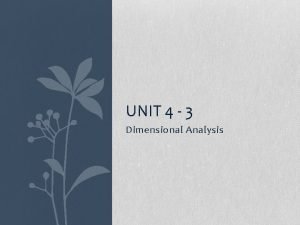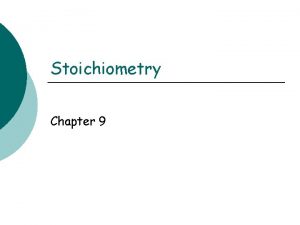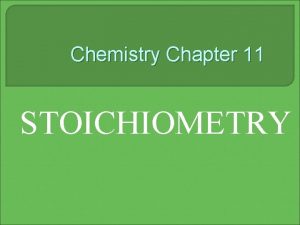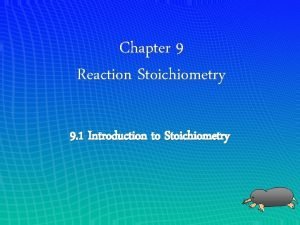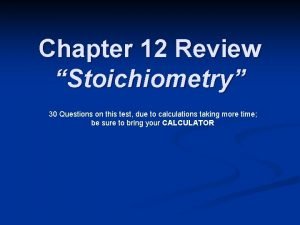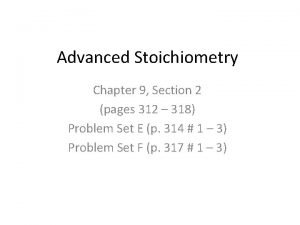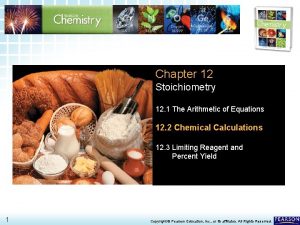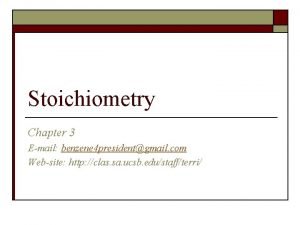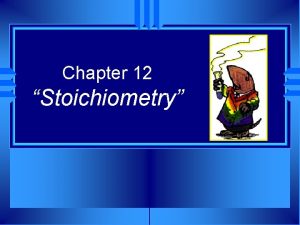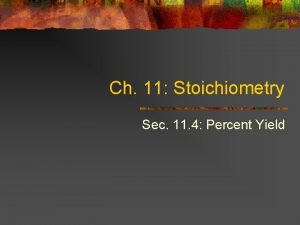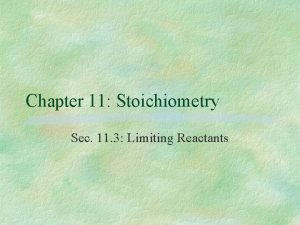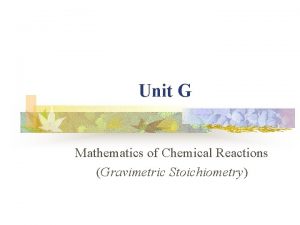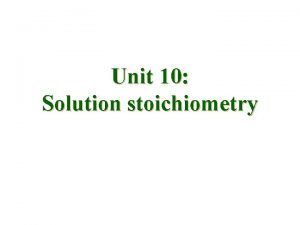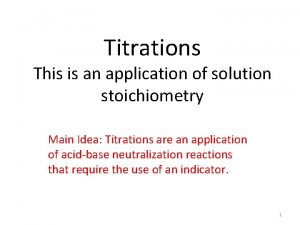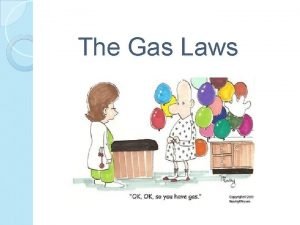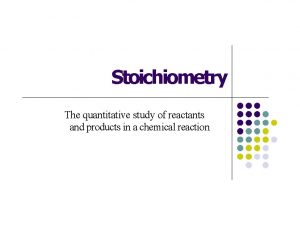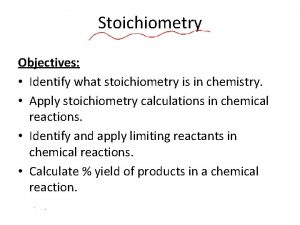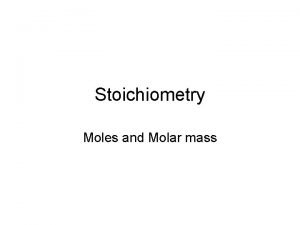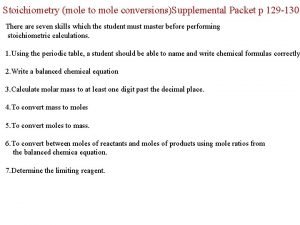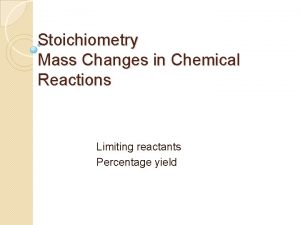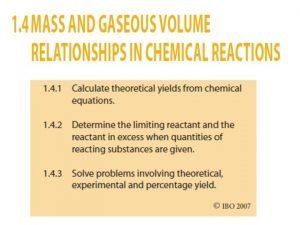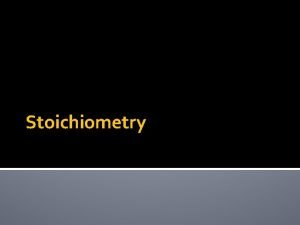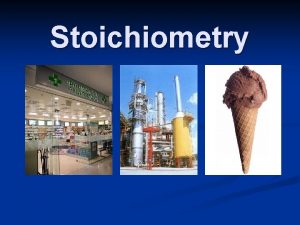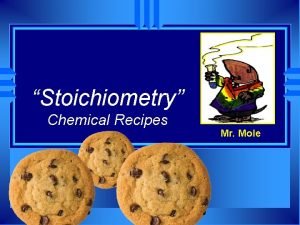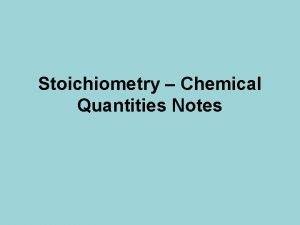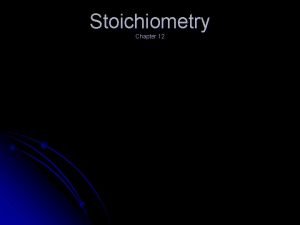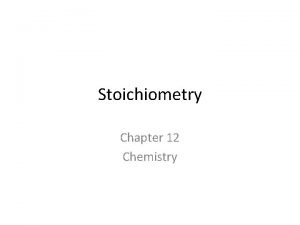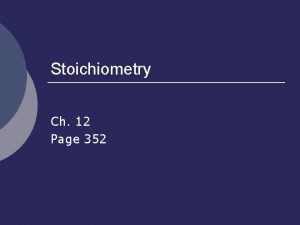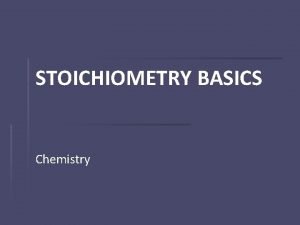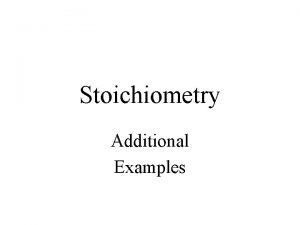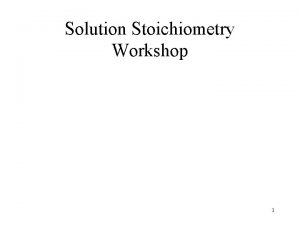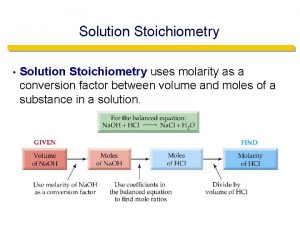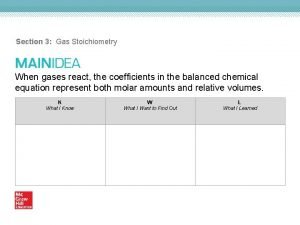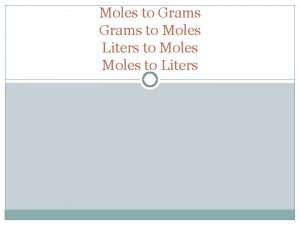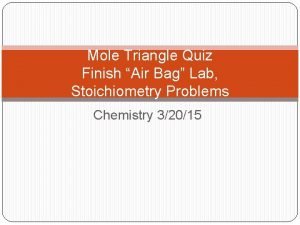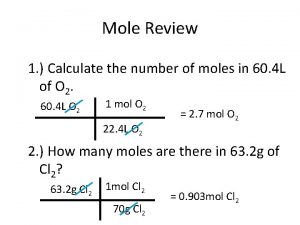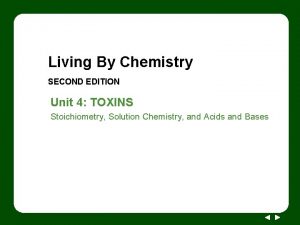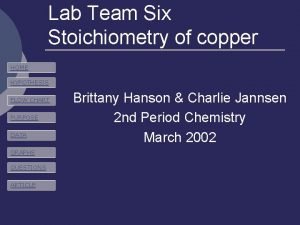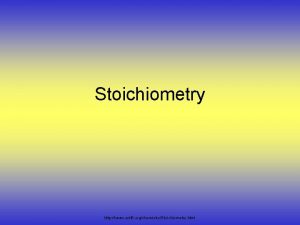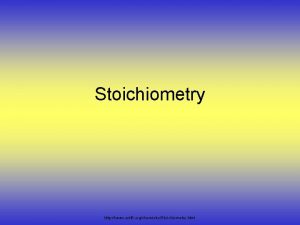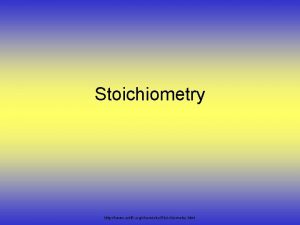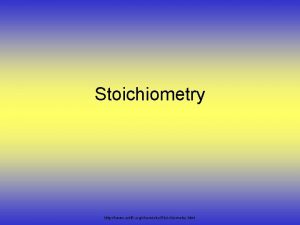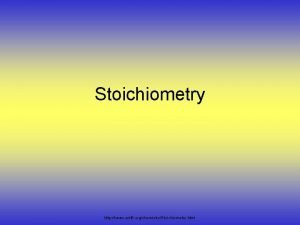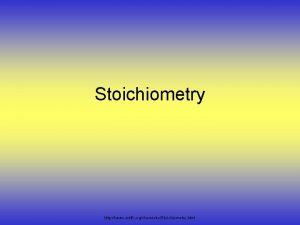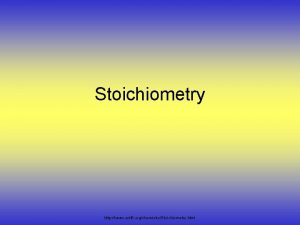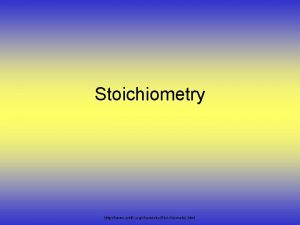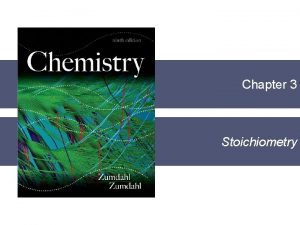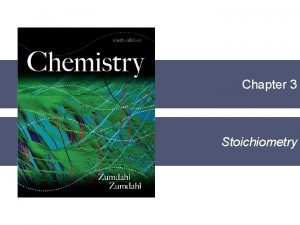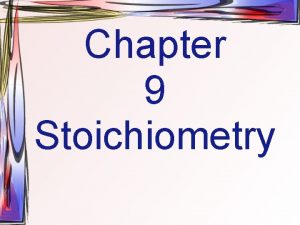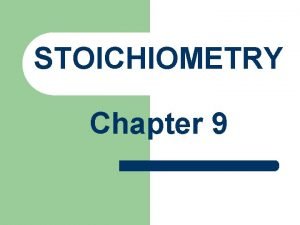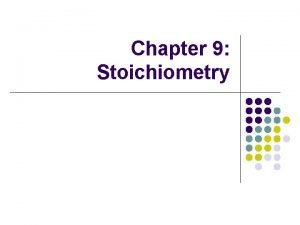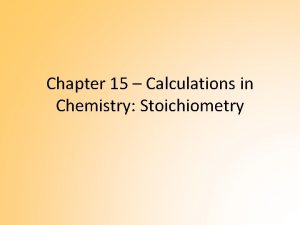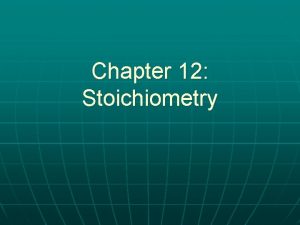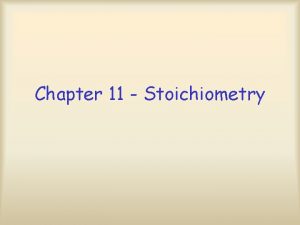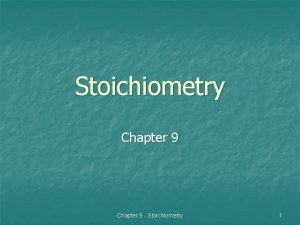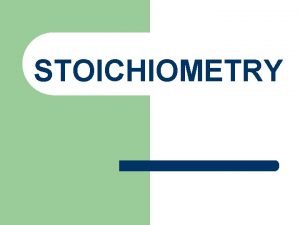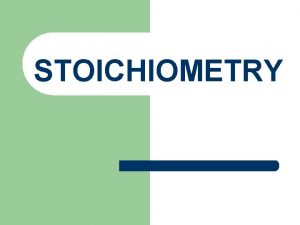Stoichiometry Chapter 11 http www unit 5 orgchemistryStoichiometry
























































- Slides: 56

Stoichiometry Chapter 11 http: //www. unit 5. org/chemistry/Stoichiometry. html

Stoichiometry You should understand ØMoles, mass, representative particles (atoms, molecules, formula units), molar mass, and Avogadro’s number. ØThe percent composition of an element in a compound. ØBalanced chemical equations: for example, for a given mass of a reactant, calculate the amount of produced. ØLimiting reactants: calculate the amount of product formed when given the amounts of all the reactants present. ØThe percent yield of a reaction.

Some common collections and the numbers of items in them. Timberlake, Chemistry 7 th Edition, page 179

CH 4 + 2 O 2 CO 2 + 2 H 2 O Reactants 1 C atom 4 H atoms 4 O atoms Timberlake, Chemistry 7 th Edition, page 167 Products 1 C atom 4 H atoms 4 O atoms

Reactants Products + C(s) + carbon O 2(g) CO 2(g) oxygen carbon dioxide Reactants 1 carbon atom 2 oxygen atoms Product 1 carbon atom 2 oxygen atoms catalyst – speeds up reaction + 2 H 2(g) + hydrogen Pt O 2(g) Pt oxygen Reactants 2 hydrogen atoms 4 2 oxygen atoms Timberlake, Chemistry 7 th Edition, page 164 2 H 2 O (l) water Product 2 hydrogen atoms 4 1 oxygen atoms 2 Unbalanced

Unbalanced and Balanced Equations H Cl Cl H H Cl H 2 + Cl 2 HCl (unbalanced) reactants H Cl 2 2 H H Cl Cl Cl H 2 + Cl 2 2 HCl (balanced) reactants products 1 1 Cl H Cl 2 2 products 2 2

Meaning of Chemical Formula Chemical Symbol Meaning Composition H 2 O One molecule of water: Two H atoms and one O atom 2 H 2 O Two molecules of water: Four H atoms and two O atoms One molecule of hydrogen peroxide: Two H atoms and two O atoms H 2 O 2

Welcome to Mole Island 1 mol = molar mass 1 mole = 22. 4 L @ STP 1 mol = 6. 02 x 1023 particles

Stoichiometry Island Diagram Known Unknown Substance A Substance B M Mass Mountain Mass Mole Island Liter Lagoon V Volume Mole Volume Particles P Particle Place Stoichiometry Island Diagram

Stoichiometry Island Diagram Mass 1 Known Unknown Substance A Substance B m ole g) = m r ola rm as s( Volume g) Use coefficients from balanced chemical equation 1 mole = 22. 4 L @ STP Mole a m ( ss Mass m = m 1 1 mole = 22. 4 L @ STP Mole Volume (gases) s Particles 1 le tic ar p ) 23 0 les x 1 lecu 2 o 02 6. or m = s m ole (ato m Stoichiometry Island Diagram 1 m ole (a to m = 6. 02 2 so rm x 1 0 23 ole pa cu r les ticle ) s Particles

Stoichiometry Island Diagram Known Unknown Substance A Substance B M Mass Mountain Mass Liter Lagoon V Volume Mole Volume Particles P Particle Place Stoichiometry Island Diagram

Visualizing a Chemical Reaction 2 Na 10 mole Na ___ + Cl 2 5 mole Cl 2 ___ 2 Na. Cl 10 ? mole Na. Cl ___

Visualizing a Chemical Reaction 2 Na 10 mole Na ___ + Cl 2 5 mole Cl 2 ___ 2 Na. Cl 10 mole Na. Cl ___

Proportional Relationships 2 1/4 c. flour 1 tsp. baking soda 1 tsp. salt 1 c. butter 3/4 c. sugar 3/4 c. brown sugar 1 tsp vanilla extract 2 eggs 2 c. chocolate chips Makes 5 dozen cookies. I have 5 eggs. How many cookies can I make? 5 eggs 5 doz. 2 eggs Ratio of eggs to cookies 150 dozen cookies = 12. 5 Courtesy Christy Johannesson www. nisd. net/communicationsarts/pages/chem

Proportional Relationships • Stoichiometry – mass relationships between substances in a chemical reaction – based on the mole ratio • Mole Ratio – indicated by coefficients in a balanced equation 2 Mg + O 2 2 Mg. O Courtesy Christy Johannesson www. nisd. net/communicationsarts/pages/chem

Stoichiometry Steps 1. Write a balanced equation. 2. Identify known & unknown. 3. Line up conversion factors. – – – Mole ratio Molarratio mass Mole - Molarity Molar volume - moles grams moles liters soln moles liters gas Core step in all stoichiometry problems!! 4. Check answer. Courtesy Christy Johannesson www. nisd. net/communicationsarts/pages/chem

Molar Volume at STP 1 mol of a gas=22. 4 L at STP Standard Temperature & 0°C and 1 atm Courtesy Christy Johannesson www. nisd. net/communicationsarts/pages/chem Pressure

Molar Volume at STP LITERS OF GAS AT STP Molar Volume (22. 4 L/mol) MASS IN GRAMS Molar Mass (g/mol) 6. 02 1023 MOLES particles/mol NUMBER OF PARTICLES Molarity (mol/L) LITERS OF SOLUTION Courtesy Christy Johannesson www. nisd. net/communicationsarts/pages/chem

Stoichiometry Problems How many moles of KCl. O 3 must decompose in order to produce 9 moles of oxygen gas? 2 KCl. O 3 2 KCl + 3 O 2 ? mol 9 mol O 2 9 mol 2 mol KCl. O 3 3 mol O 2 = 6 mol KCl. O 3 Courtesy Christy Johannesson www. nisd. net/communicationsarts/pages/chem

How many moles of KCl. O 3 must decompose in order to produce 9 moles of oxygen gas? 2 KCl. O 3 2 KCl + 3 O 2 ? mol 9 mol O 2 9 mol 2 mol KCl. O 3 3 mol O 2 x mol KCl. O 3 = 9 mol O 2 2 mol KCl. O 3 3 mol O 2 = 6 mol KCl. O 3 6 mol = 6 mol KCl. O 3 Courtesy Christy Johannesson www. nisd. net/communicationsarts/pages/chem

Stoichiometry Problems How many grams of KCl. O 3 are required to produce 9. 00 L of O 2 at STP? 2 KCl. O 3 2 KCl + 3 O 2 ? g 9. 00 L O 2 1 mol O 2 2 mol 122. 55 KCl. O 3 g KCl. O 3 22. 4 L O 2 3 mol O 2 1 mol KCl. O 3 Courtesy Christy Johannesson www. nisd. net/communicationsarts/pages/chem = 32. 8 g KCl. O 3

Stoichiometry Problems How many grams of KCl. O 3 are required to produce 9. 00 L of O 2 at STP? 2 KCl. O 3 2 KCl + 3 O 2 ? g 9. 00 L x g KCl. O 3 = 9. 00 L O 2 1 mol O 2 22. 4 L O 2 32. 8 g 2 mol KCl. O 3 122. 55 g KCl. O 3 = 32. 8 g KCl. O 3 3 mol O 2 1 mol KCl. O 3 Courtesy Christy Johannesson www. nisd. net/communicationsarts/pages/chem

How many grams of KCl. O 3 are required to produce 9. 00 L of O 2 at STP? 2 KCl. O 3 2 KCl + 3 O 2 ? g 9. 00 L O 2 1 mol O 2 2 mol 122. 55 KCl. O 3 g KCl. O 3 22. 4 L O 2 3 mol O 2 x g KCl. O 3 = 9. 00 L O 2 1 mol O 2 22. 4 L O 2 1 mol KCl. O 3 = 32. 8 g KCl. O 3 32. 8 g 2 mol KCl. O 3 122. 55 g KCl. O 3 = 32. 8 g KCl. O 3 3 mol O 2 1 mol KCl. O 3 Courtesy Christy Johannesson www. nisd. net/communicationsarts/pages/chem

How many grams of silver will be formed from 12. 0 g copper? Cu + 2 Ag. NO 3 2 Ag + Cu(NO 3)2 12. 0 g Cu ? g 1 mol Cu 2 mol Ag 107. 87 g Ag 63. 55 g Cu 1 mol Ag x g Ag = 12. 0 g Cu Cu = 40. 7 g Ag 2 mol Ag 107. 87 g Ag 1 mol Cu 1 mol Ag 63. 55 g Cu 1 mol Cu Ag Courtesy Christy Johannesson www. nisd. net/communicationsarts/pages/chem 40. 7 g = 40. 7 g Ag

Limiting Reactants + 48 tires 8 car bodies CB plus 16 tires excess + 4 T 8 cars CT 4

Limiting Reactants Methane, CH 4 + 24 hydrogen molecules 8 carbon atoms C plus 16 8 hydrogen molecules atoms excess + 2 H 2 8 methane molecules CH 4

Container 1 Zumdahl, De. Coste, World of Chemistry 2002, page 269

Before and After Reaction 1 N 2 + 3 H 2 Before the reaction 2 NH 3 After the reaction All the hydrogen and nitrogen atoms combine. Zumdahl, De. Coste, World of Chemistry 2002, page 269

Container 2 Zumdahl, De. Coste, World of Chemistry 2002, page 270

Before and After Reaction 2 N 2 + 3 H 2 excess 2 NH 3 limiting Before the reaction After the reaction LIMITING REACTANT DETERMINES AMOUNT OF PRODUCT Zumdahl, De. Coste, World of Chemistry 2002, page 270

Real-World Stoichiometry: Limiting Reactants Fe + S Fe. S Ideal Stoichiometry Limiting Reactants S= Fe = Le. May Jr, Beall, Robblee, Brower, Chemistry Connections to Our Changing World , 1996, page 366 excess

Grilled Cheese Sandwich Bread + 2 B + 100 bread Cheese C 30 slices ‘Cheese Melt’ B 2 C 30 ? sandwiches Multiple Guess: 130 sandwiches 100 sandwiches 90 sandwiches 60 sandwiches 30 sandwiches Not enough information given

Limiting Reactants • Available Ingredients – 4 slices of bread – 1 jar of peanut butter – 1/2 jar of jelly • Limiting Reactant – bread • Excess Reactants – peanut butter and jelly Courtesy Christy Johannesson www. nisd. net/communicationsarts/pages/chem

Limiting Reactants • Limiting Reactant – used up in a reaction – determines the amount of product • Excess Reactant – added to ensure that the other reactant is completely used up – cheaper & easier to recycle Courtesy Christy Johannesson www. nisd. net/communicationsarts/pages/chem

The Limiting Reactant A balanced equation for making a Big Mac® might be: 3 B + 2 M + EE B 3 M 2 EE With… …and… …one can make… 30 M excess B and excess EE 15 B 3 M 2 EE 30 B excess M and excess EE 10 B 3 M 2 EE 30 M 30 B and excess EE 10 B 3 M 2 EE

The Limiting Reactant A balanced equation for making a tricycle might be: 3 W + 2 P + S + H + F W 3 P 2 SHF With… …and… …one can make… 50 P excess of all other reactants 25 W 3 P 2 SHF 50 S excess of all other reactants 50 W 3 P 2 SHF 50 P 50 S and excess of all other reactants 25 W 3 P 2 SHF

Limiting Reactants aluminum + chlorine gas Al(s) + Cl 2(g) Al. Cl 3 2 Al(s) + 3 Cl 2(g) 2 Al. Cl 3 100 g A. 200 g aluminum chloride 100 g B. 125 g ? g C. 667 g D. 494 g

Limiting Reactants aluminum 2 Al(s) 100 g + + chlorine gas 3 Cl 2(g) 100 g aluminum chloride 2 Al. Cl 3 xg How much product would be made if we begin with 100 g of aluminum? x g Al. Cl 3 = 100 g Al Al 1 mol Al 27 g Al 2 mol Al. Cl 3 133. 5 g Al. Cl 3 2 mol Al 1 mol Al. Cl 3 = 494 g Al. Cl 3 How much product would be made if we begin with 100 g of chlorine gas? x g Al. Cl 3 = 100 g Cl 2 Al. Cl 3 1 mol Cl 2 71 g Cl 2 2 mol Al. Cl 3 133. 5 g Al. Cl 3 3 mol Cl 2 1 mol Al. Cl 3 = 125 g Al. Cl 3

Limiting Reactants – Method 1 1. Write a balanced equation. 2. For each reactant, calculate the amount of product formed. 3. Smaller answer indicates: – limiting reactant – amount of product Courtesy Christy Johannesson www. nisd. net/communicationsarts/pages/chem

Limiting Reactants – Method 2 • Begin by writing a correctly balanced chemical equation • Write down all quantitative values under equation (include units) • Convert ALL reactants to units of moles • Divide by the coefficient in front of each reactant • The smallest value is the limiting reactant!

Stoichiometry in the Real World

Air Bag Design • Exact quantity of nitrogen gas must be produced in an instant. • Use a catalyst to speed up the reaction 2 Na. N 3(s) 2 Na(s) + 3 N 2(g) 6 Na(s) + Fe 2 O 3(s) 3 Na 2 O(s) + 2 Fe (s)

2 Na. N 3(s) 2 Na(s) + 3 N 2(g) 6 Na(s) + Fe 2 O 3(s) 3 Na 2 O(s) + 2 Fe(s) Airbag Design Assume that 65. 1 L of N 2 gas are needed to inflate an air bag to the proper size. How many grams of Na. N 3 must be included in the gas generant to generate this amount of N 2? (Hint: The density of N 2 gas at this temperature is about 0. 916 g/L). 65. 1 L N 2 x 0. 916 g/L N 2 x g Na. N 3 = 59. 6 g N 2 1 mol N 2 2 mol Na. N 3 65 g Na. N 3 28 g N 2 3 mol N 2 1 mol Na. N 3 X = 92. 2 g Na. N 3 How much Fe 2 O 3 must be added to the gas generant for this amount of Na. N 3? x g Fe 2 O 3 = 92. 2 g Na. N 3 1 mol Na. N 3 2 mol Na 1 mol Fe 2 O 3 159. 6 g Fe 2 O 3 65 g Na. N 3 2 mol Na. N 3 6 mol Na 1 mol Fe 2 O 3 X = 37. 7 g Fe 2 O 3

Water from a Camels store the fat tristearin (C 57 H 110 O 6) in the hump. As well as being a source of energy, the fat is a source of water, because when it is used the reaction 2 C 57 H 110 O 6(s) + 163 O 2(g) 114 CO 2(g) + 110 H 2 O(l) takes place. What mass of water can be made from 1. 0 kg of fat? x g H 2 O = 1 kg ‘fat” 1000 g “fat” 1 mol “fat” 110 mol H 2 O 18 g H 2 O 1 kg “fat” 890 g “fat” 2 mol “fat” 1 mol H 2 O X = 1112 g H 2 O or 1. 112 liters water

Rocket Fuel The compound diborane (B 2 H 6) was at one time considered for use as a rocket fuel. How many grams of liquid oxygen would a rocket have to carry to burn 10 kg of diborane completely? (The products are B 2 O 3 and H 2 O). Chemical equation Balanced chemical equation B 2 H 6 + O 2 B 2 O 3 + H 2 O B 2 H 6 + 3 O 2 B 2 O 3 + 3 H 2 O 10 kg x g O 2 = 10 kg B 2 H 6 xg 1000 g B 2 H 6 1 mol B 2 H 6 1 kg B 2 H 6 28 g B 2 H 6 3 mol O 2 32 g O 2 1 mol B 2 H 6 1 mol O 2 X = 34, 286 g O 2

Water in Space Click Here In the space shuttle, the CO 2 that the crew exhales is removed from the air by a reaction within canisters of lithium hydroxide. On average, each astronaut exhales about 20. 0 mol of CO 2 daily. What volume of water will be produced when this amount of CO 2 reacts with an excess of Li. OH? (Hint: The density of water is about 1. 00 g/m. L. ) CO 2(g) + 2 Li. OH(s) Li 2 CO 3(aq) + H 2 O(l) 20. 0 mol xg excess x m. L H 2 O = 20. 0 mol CO 2 Water is NOT at STP! 1 mol H 2 O 22. 4 18 g. LHH 2 O 2 O 1 m. L H 2 O 1 mol CO 2 1 mol H 2 O 1 g H 2 O X = 360 m. L H 2 O

Lithium Hydroxide Scrubber Modified by Apollo 13 Mission Astronaut John L. Swigert holds the jury-rigged lithium hydroxide scrubber used to remove excess carbon dioxide from the damaged Apollo 13 spacecraft.

Real Life Problem Solving Determine the amount of Li. OH required for a seven-day mission in space for three astronauts and one ‘happy’ chimpanzee. Assume each passenger expels 20 mol of CO 2 per day. Note: The lithium hydroxide scrubbers are only 85% efficient. (4 passengers) x (10 days) x (20 mol/day) = 800 mol CO 2 Plan for a delay CO 2(g) + 2 Li. OH(s) Li 2 CO 3(aq) + H 2 O(l) 800 mol Xg

CO 2(g) + 2 Li. OH(s) Li 2 CO 3(aq) + H 2 O(l) 38, 240 xg g 800 mol x 23. 9 g/mol 800 mol 1: 2 1600 mol X g Li. OH = 800 mol CO 2 Needed (actual yield) 2 mol Li. OH 23. 9 g Li. OH = 38, 240 g Li. OH 1 mol CO 2 1 mol Li. OH Note: The lithium hydroxide scrubbers are only 85% efficient. % Yield = Actual Yield Theoretical Yield 0. 85 = Amount of Li. OH to be taken into space 38, 240 g Li. OH x = 44, 988 g Li. OH

Careers in Chemistry: Farming is big business in the United States with profits for the lucky and possible bankruptcy for the less fortunate. Farmers should not be ignorant of chemistry. For instance, to be profitable, a farmer must know when to plant, harvest, and sell his/her crops to maximize profit. In order to get the greatest yield farmers often add fertilizers to the soil to replenish vital nutrients removed by the previous season’s crop. Corn is one product that removes a tremendous amount of phosphorous from the soil. For this reason, farmers will rotate crops and/or add fertilizer to the ground before planting crops for the following year. On average, an acre of corn will remove 6 kilograms of phosphorous from the ground. Assume you inherit a farm and must now have to purchase fertilizer for the farm. The farm is 340 acres and had corn planted the previous year. You must add fertilizer to the soil before you plant this years’ crop. You go to the local fertilizer store and find Super. Phosphate. TM brand fertilizer. You read the fertilizer bag and can recognize from your high school chemistry class a molecular formula Ca 3 P 2 H 14 S 2 O 21 (you don’t understand anything else written on the bag because it is imported fertilizer from Japan). You must decide how much fertilizer to buy for application to your corn fields. If each bag costs $54. 73; how many bags of fertilizer must you purchase and how much will it cost you to add the necessary fertilizer to your fields? Given: 1 bag of fertilizer weighs 10, 000 g [454 g = 1 pound]

Careers in Chemistry: Farming How much fertilizer will you need? Conversion Factor: 1 acre corn = 6 kg phosphorous x g P = 340 acres 6 kg P 1 acre 1000 g P 1 kg P = 2. 04 x 106 g P If a bag of fertilizer has the formula Ca 3 P 2 H 14 S 2 O 21, The molar mass of it is 596 g/mol. 3 Ca @ 40 g/mol 2 P@ 31 g/mol 14 H@ 1 g/mol 2 S@ 32 g/mol 21 O @ 16 g/mol Ca 3 P 2 H 14 S 2 O 21 = 120 g = 62 g = 14 g = 64 g = 335 g = 596 g %P = 10. 4 % Phosphorous In a bag of fertilizer you have 10. 4 % (by mass) phosphorous. A bag of fertilizer weighs 10, 000 g (about 22 pounds). 10. 4 % of 10, 000 g = 1040 g phosphorous / bag of fertilizer 2. 04 x 106 g P = 1962 bags of fertilizer 1040 g/bag Total Cost (1962 bags of fertilizer)($54. 73 / bag) = $107, 380 part 62 g x 100 % whole 596 g

Careers in Chemistry: Dentistry We learned that fluoride is an essential element to be taken to reduce teeth cavities. Too much fluoride can produce yellow spots on the teeth and too little will have no effect. After years of study it was determined that a quantity of 1 part per million (ppm) fluoride in the water supply is enough to significantly reduce cavities and not stain teeth yellow. Measure the mass of the mineral fluorite (chemically, Ca. F 2). Use this sample to determine how much water must be added to yield a 1 ppm fluoride solution. Sounds difficult? Lets apply what we’ve learned this unit to solve this problem. 1 part per million = 1 atom of fluorine per 999, 999 water molecules What information do we know: 1 mol Ca. F 2 = 78. 08 g Ca. F 2 = 6. 02 x 1023 molecules of Ca. F 2 1 molecules of Ca. F 2 = 2 atoms of F 1 mol H 2 O = 18 g H 2 O Density of water is 1 g/m. L 1000 m. L = 1 L and 3. 78 L = 1 gallon mass of sample of Ca. F 2 = 92. 135 g

Careers in Chemistry: Dentistry Calcium Fluoride x atoms F = 92. 135 g Ca. F 2 x gallons H 2 O = 1. 42 x 1024 F atoms Need 1 mol Ca. F 2 6. 02 x 1023 molecules Ca. F 2 2 atoms F 78 g Ca. F 2 1 molecules Ca. F 2 999, 999 H 2 O molecules 1 F atom 11, 238 gallons of water 1 mol H 2 O 18 g H 2 O 6. 02 x 1023 H 2 O molecules 1 mol H 2 O needed to dissolve 91. 235 g Ca. F 2 = 1. 42 x 1024 atoms F 1 m. L H 2 O 1 gallon H 2 O 1 g H 2 O 1000 m. L H 2 O 3. 78 L H 2 O to yield a 1 ppm F 1 - solution. =

Percent Yield measured in lab % yield = actual yield theoretical yield calculated on paper x 100

When 45. 8 g of K 2 CO 3 react with excess HCl, 46. 3 g of KCl are formed. Calculate theoretical and % yields of KCl. actual yield 46. 3 g K 2 CO 3 + 2 HCl 45. 8 g excess 2 KCl + H 2 O CO+3 CO 2 ? g theoretical yield Theoretical yield x g KCl = 45. 8 g K 2 CO 3 % Yield = 1 mol K 2 CO 3 2 mol KCl 74. 5 g KCl = 49. 4 g KCl 1 mol K CO 1 mol KCl 138 g K 2 CO 3 2 3 Actual Yield Theoretical Yield % Yield = 46. 3 g KCl x 100 % Yield = 93. 7% efficient

Cartoon courtesy of Nearing. Zero. net
 Chapter 11 chapter assessment stoichiometry answer key
Chapter 11 chapter assessment stoichiometry answer key Unit: stoichiometry “multi-step problems” – ws #3
Unit: stoichiometry “multi-step problems” – ws #3 Unit 6 review questions
Unit 6 review questions Http //mbs.meb.gov.tr/ http //www.alantercihleri.com
Http //mbs.meb.gov.tr/ http //www.alantercihleri.com Http //siat.ung.ac.id atau http //pmb.ung.ac.id
Http //siat.ung.ac.id atau http //pmb.ung.ac.id Chemistry chapter 9 stoichiometry
Chemistry chapter 9 stoichiometry Chapter 9 review stoichiometry
Chapter 9 review stoichiometry Stoichiometry defintion
Stoichiometry defintion A balanced chemical equation allows one to determine the
A balanced chemical equation allows one to determine the Stoichiometry introduction
Stoichiometry introduction The first step in most stoichiometry problems is to ____.
The first step in most stoichiometry problems is to ____. Percentage yield
Percentage yield Chapter 12 stoichiometry answer key pearson
Chapter 12 stoichiometry answer key pearson Stoichiometry mass to mass formula
Stoichiometry mass to mass formula Chapter 3 stoichiometry answer key
Chapter 3 stoichiometry answer key Chapter 12 stoichiometry
Chapter 12 stoichiometry Define percent yield
Define percent yield 11-3 practice problems chemistry answers
11-3 practice problems chemistry answers Gravimetric stoichiometry
Gravimetric stoichiometry Stoichiometry mole island diagram
Stoichiometry mole island diagram Grams to gram
Grams to gram Chemical rxns/balancing equ./stoichiometry
Chemical rxns/balancing equ./stoichiometry How to calculate molarity
How to calculate molarity Titration stoichiometry
Titration stoichiometry Stoichiometry game
Stoichiometry game Number of moles formula
Number of moles formula Gas stoichiometry worksheet
Gas stoichiometry worksheet In a chemical reaction stoichiometry refers to
In a chemical reaction stoichiometry refers to Stoichiometry deals with...
Stoichiometry deals with... Stoichiometry
Stoichiometry What is composition stoichiometry
What is composition stoichiometry What stoichiometry
What stoichiometry Stoichiometry island
Stoichiometry island Stoichiometry
Stoichiometry Stoichiometry examples
Stoichiometry examples Stoichiometry is the study of
Stoichiometry is the study of Introduction to stoichiometry
Introduction to stoichiometry Stoicheion elements
Stoicheion elements Stoichiometry definition
Stoichiometry definition What does stoichiometry mean in greek
What does stoichiometry mean in greek Stoichiometry cookie lab
Stoichiometry cookie lab Stoichiometry formulas
Stoichiometry formulas Cookie stoichiometry
Cookie stoichiometry Stoichiometry
Stoichiometry What is stoichiometry
What is stoichiometry Stoichiometry basics
Stoichiometry basics Example of stoichiometry
Example of stoichiometry Solution
Solution Molarity stoichiometry
Molarity stoichiometry Gas stoichiometry
Gas stoichiometry Stoichiometry island
Stoichiometry island Convert moles to liters
Convert moles to liters Mass formula
Mass formula Stoichiometry triangle
Stoichiometry triangle Stoichiometry formulas
Stoichiometry formulas Lesson 92 mole tunnel stoichiometry
Lesson 92 mole tunnel stoichiometry Stoichiometry flow chart
Stoichiometry flow chart

